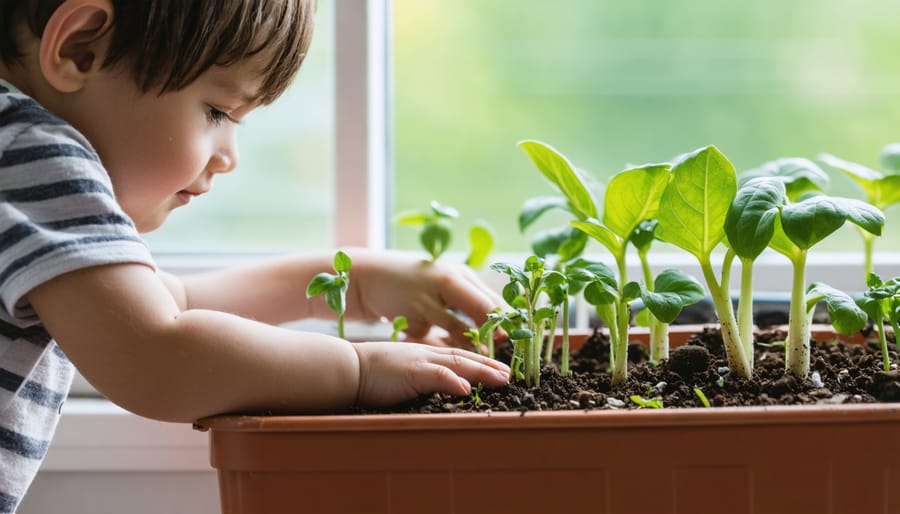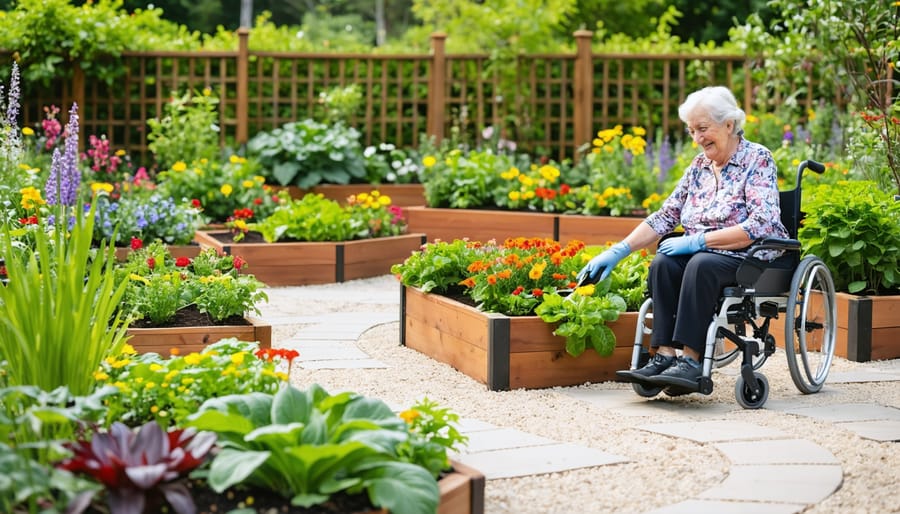Transform a simple window box into a child’s first garden adventure by planting fast-growing radishes and lettuce that sprout within days, creating immediate excitement and ownership. Engage young minds through engaging gardening activities for preschoolers like creating miniature fairy gardens with moss, pebbles, and tiny succulents, sparking creativity while teaching plant care basics.
Beyond the proven health benefits of gardening, introducing children to the garden cultivates patience, responsibility, and environmental awareness through hands-on learning. Design sensory-rich experiences by growing aromatic herbs like mint and lavender alongside textured plants such as lamb’s ear, encouraging exploration through touch and smell while building lasting connections to nature.
Start simple projects like sprouting beans in clear jars or creating themed pizza gardens with tomatoes and basil, making the learning process both educational and delicious. These accessible activities lay the foundation for a lifetime of gardening enthusiasm while developing fine motor skills and scientific understanding in young gardeners.
Quick-Reward Projects for Instant Excitement
Sprouting Seeds in Paper Towels
Sprouting seeds in paper towels is a magical activity that lets children witness the miracle of germination up close. This simple indoor project requires just a few basic materials: paper towels, zip-lock bags, water, and your choice of seeds (bean or pea seeds work particularly well for beginners).
Start by dampening a paper towel – it should be moist but not dripping wet. Help your child place several seeds on one half of the towel, then fold the other half over to cover them. Slide the paper towel into a clear plastic bag and seal it, leaving a small air gap at the top. Place the bag in a warm spot near a window, but avoid direct sunlight.
The exciting part comes in just a few days when tiny roots begin to emerge! Encourage your child to check their seeds daily and keep a simple growth diary with drawings or photographs. Most seeds will sprout within 3-7 days, making this the perfect activity for young gardeners who are still developing patience.
Once the seedlings develop their first true leaves, they can be carefully transferred to soil pots. This activity not only teaches children about plant life cycles but also helps develop their observation skills and scientific thinking.
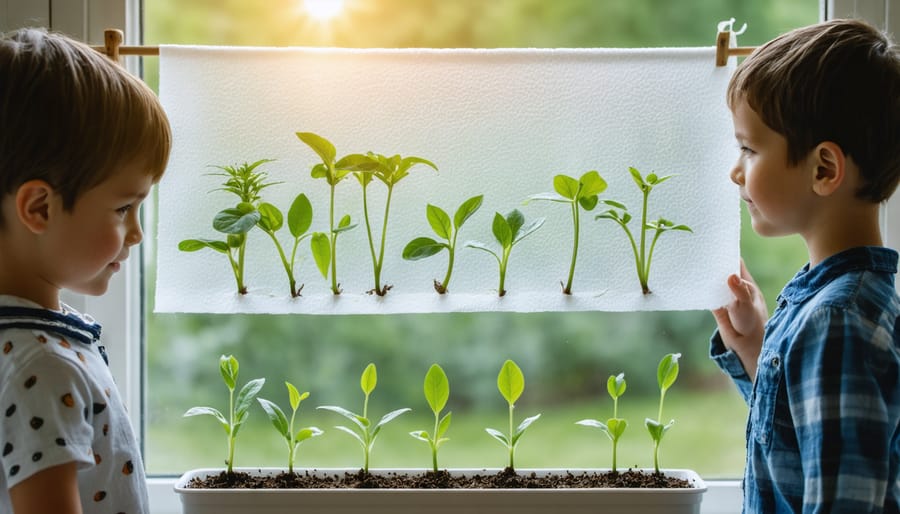
Growing Microgreens and Cress Heads
Microgreens and cress heads are perfect starter projects for young gardeners, offering quick results that keep children engaged and excited about growing their own food. These tiny powerhouses can be ready to harvest in as little as 7-10 days, making them ideal for developing patience and responsibility without the long wait.
Start by spreading microgreen seeds densely across a shallow tray filled with potting soil. Popular choices include radish, basil, and sunflower microgreens, which are both easy to grow and packed with nutrients. Keep the soil consistently moist and place the tray in a sunny spot or under grow lights. Children will love watching the daily progress as their mini garden springs to life.
For a creative twist, try making cress heads using old stockings or eggshells. Fill your chosen container with cotton wool or potting mix, sprinkle cress seeds generously, and add googly eyes and decorations to create funny faces. As the cress grows, it becomes wild, green “hair” that children can trim and eat. This project combines crafting with edible gardening, making it doubly engaging for kids.
Remember to involve children in the harvesting process – they’re more likely to try new foods they’ve grown themselves. These tiny greens make excellent additions to sandwiches and salads, introducing children to healthy eating habits through gardening.
Sensory Garden Adventures
Touch-and-Feel Plant Selection
Introducing children to plants with different textures is an exciting way to create a hands-on learning experience. When planning your sensory garden design, choose plants that are both safe to touch and engaging for little hands.
Lamb’s ear (Stachys byzantina) is a fantastic starter plant, with its soft, fuzzy leaves that feel like a pet’s ear. Children love running their fingers across its velvety surface. For interesting contrasts, consider including smooth-leaved succulents like jade plants or the rippled edges of kale leaves.
The feathery fronds of cosmos and fennel provide delicate textures that dancing fingers can explore safely. Ornamental grasses like fountain grass offer swooshing sounds and gentle movements when touched. mint varieties are also excellent choices, offering both tactile and aromatic experiences.
Remember to supervise young gardeners and teach them which plants are safe to touch. Avoid plants with thorns, sharp edges, or known irritants. Place touch-friendly plants at child height in raised beds or containers for easy access.
Create texture stations by grouping plants with similar feels together – soft and fuzzy in one area, smooth and waxy in another. This arrangement helps children understand plant diversity while keeping exploration organized and safe. Label each plant clearly with both its name and a “touching allowed” symbol to encourage confident exploration.
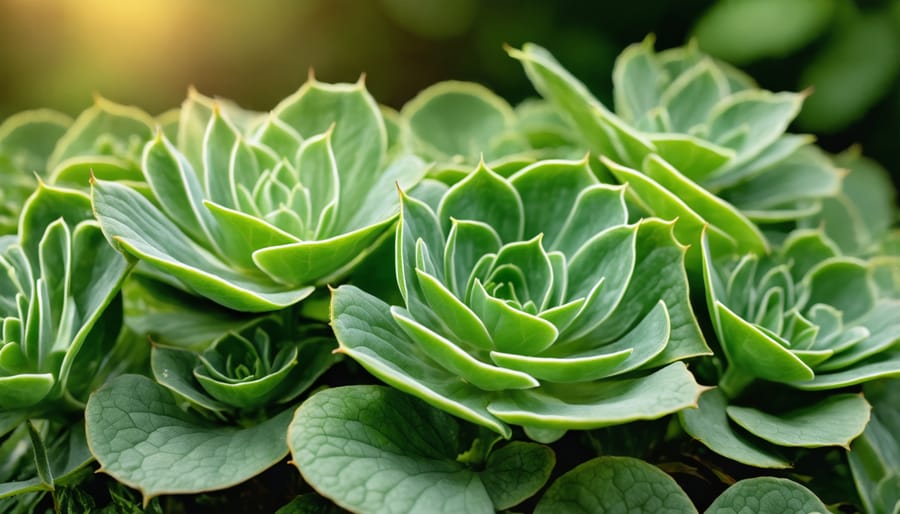
Edible Flower and Herb Garden
Creating an edible flower and herb garden is a magical way to teach children that some plants are not just beautiful but also delicious. Start by selecting child-safe plants like pansies, nasturtiums, and marigolds for flowers, alongside familiar herbs such as mint, basil, and lemon balm. Always supervise young gardeners and teach them that they should never eat any plant without an adult’s permission.
Designate a special area in your garden or use containers on a patio, ensuring the soil is rich and well-draining. Let children help with the planting process by creating fun patterns or rainbow-themed rows. Mint makes an excellent starter herb as it’s hardy and grows vigorously, while nasturtiums offer both edible flowers and leaves with a peppery kick that kids find fascinating.
Make the experience interactive by encouraging children to smell herbs before and after watering, touch the different leaf textures, and observe visiting pollinators. Create simple recipes together using your harvest – mint tea, herb-infused water, or flower-decorated cupcakes are usually big hits with young gardeners.
Label plants clearly using decorated wooden stakes, which children can help create. This not only makes identification easier but also helps with reading skills. Remember to choose organic growing methods and avoid any chemical pesticides since these plants will be consumed.
Creative Garden Projects
Building Bug Hotels
Building bug hotels is a fantastic way to teach children about beneficial insects while creating a valuable garden habitat. Start by gathering natural materials like hollow bamboo stems, pinecones, twigs, and bark – a perfect excuse for a nature scavenger hunt! Let your kids arrange these materials inside a wooden frame or old box, creating different-sized holes and tunnels for various insects.
Make it educational by explaining how different bugs help our gardens: ladybugs eat pesky aphids, while solitary bees are excellent pollinators. Children love knowing they’re creating homes for these helpful garden friends. Layer the materials horizontally, ensuring they’re packed tightly enough to stay in place but leaving enough gaps for insects to move through.
Place your finished bug hotel in a quiet corner of the garden, preferably somewhere slightly elevated and sheltered from rain. Encourage kids to check their hotel regularly (but quietly!) to spot new residents. This ongoing project helps children develop a deeper connection with nature while understanding the importance of biodiversity in their garden.
Remember to take photos of your creation and keep a log of which insects visit – it’s amazing how quickly these mini wildlife havens become bustling with activity!
Painted Plant Markers
Transform ordinary garden markers into colorful works of art with this engaging activity that combines creativity and learning. Start by collecting smooth, flat rocks or wooden craft sticks – both make excellent canvas choices for young artists. Using weather-resistant acrylic paints, let children decorate their markers with vibrant colors and fun patterns. They can paint vegetables, fruits, or flowers on one side and write the plant names on the other.
For younger children, you might want to write the plant names first in pencil for them to trace with paint. Older kids can practice their handwriting while learning plant spelling. Make it extra special by encouraging them to add their own creative touches, like ladybugs, butterflies, or silly faces.
Once the paint dries, seal the markers with clear outdoor sealant to protect them from rain and watering. This not only helps children identify what’s growing where but also gives them a sense of ownership over their garden space. Plus, these personalized markers make wonderful keepsakes that capture memories of their gardening adventures.
Remember to lay down newspaper or an old tablecloth before starting, and have children wear old clothes or aprons to protect from paint spills.
Mini Fairy Gardens
Mini fairy gardens captivate children’s imagination while teaching them about plant care and creative landscaping. Start by selecting a shallow container with drainage holes and fill it with potting soil. Let your little ones choose tiny plants like moss, baby tears, or small succulents that will serve as the garden’s living elements.
Guide children in creating magical features using natural materials: twigs become fairy fences, pebbles transform into winding paths, and small shells can be tiny swimming pools. Add miniature furniture, which you can either purchase or craft together using items from nature. Encourage kids to include tiny fairy houses made from bark, pinecones, or recycled materials.
The real magic happens when children maintain their fairy gardens. They’ll learn responsibility by watering the plants, trimming overgrown areas, and keeping their miniature world tidy. This ongoing project offers endless opportunities for storytelling and imagination as children create narratives about the fairy residents of their garden.
Remember to place the fairy garden where children can easily access and observe it, whether indoors near a sunny window or in a sheltered outdoor spot.
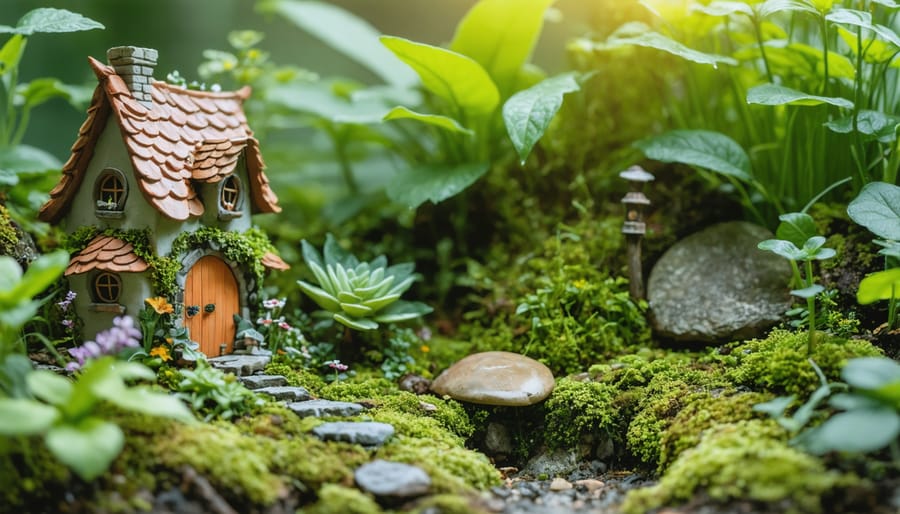
Safety and Success Tips
Safety should always come first when gardening with children. Start by choosing child-safe tools that are appropriately sized for small hands. Look for plastic or lightweight materials with rounded edges and ensure all tools are properly maintained to prevent accidents.
Always supervise children during gardening activities and teach them proper tool handling. Establish clear rules about not swinging tools around or pointing them at others. When not in use, store tools safely out of children’s reach.
Protect young gardeners by having them wear closed-toe shoes, sun hats, and sunscreen. Garden gloves are essential to prevent cuts and protect from soil-borne bacteria. Keep a first aid kit nearby and ensure children wash their hands thoroughly after gardening sessions.
Be mindful of plant selection. Avoid varieties with thorns, sharp edges, or toxic properties. Research plants beforehand and clearly mark areas that children should avoid. Create designated paths through the garden to prevent accidental stepping on plants or tripping hazards.
Keep sessions short and engaging to maintain interest. Mix physical activities with rest periods and incorporate games or challenges. Break larger projects into manageable tasks that provide quick wins and boost confidence.
Stay hydrated, especially on warm days, and take regular breaks in shaded areas. Consider creating a special kids’ zone in the garden where they can freely explore and experiment without worry.
Remember to praise effort and celebrate small achievements. This builds confidence and creates positive associations with gardening. Keep a camera handy to document their progress and achievements, creating lasting memories of their garden adventures.
Introducing children to gardening opens up a world of endless possibilities for learning, growth, and connection with nature. Through the activities we’ve explored, from creating fairy gardens to growing edible plants, children can develop patience, responsibility, and an understanding of the environmental benefits of gardening. These hands-on experiences not only foster a love for nature but also build confidence and create lasting memories.
Remember, the key to successful gardening with children lies in keeping activities fun, age-appropriate, and engaging. Start small, celebrate every achievement, and don’t worry about perfect results. Whether you have a large backyard or just a few containers on a windowsill, there’s always room for growing together.
Take the first step today by choosing one of these activities to try with your children. Watch their eyes light up as they discover the magic of planting their first seed, and share in their excitement as they witness the miracle of growth. The garden is waiting to become your family’s newest classroom, playground, and adventure zone.

